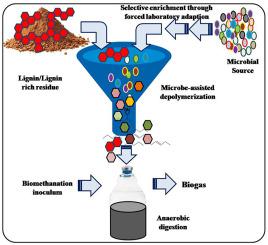Journal of Environmental Management ( IF 8.0 ) Pub Date : 2021-09-09 , DOI: 10.1016/j.jenvman.2021.113684 N L Radhika 1 , Sarita Sachdeva 2 , Manoj Kumar 3

|
Biomethanation potential of lignin rich residue (LRR) obtained from lignocellulosic ethanol fermentation was evaluated after subjecting to microbe assisted pretreatment using selectively enriched lignin depolymerizing consortia (LDC). The efficiency of LDC in lignin depolymerization was established using alkali and dealkali lignins (AL and DL) along with LRR as feedstocks. Microbial growth on media having lignin as sole carbon source, activity of lignin depolymerizing enzymes, viz., lignin peroxidase and laccase, ability of culture to decolorize the lignin mimicking dyes like methylene blue and ramezol brilliant blue, were considered to confirm the efficiency of enriched mixed culture. Microbial treatment using LDC showed significant positive impact on lignin breakdown irrespective of the substrate (LRR, 46.33%; AL, 31.37%; DL, 34.20%). The hydrolysate of LRR obtained from microbial pretreatment showed higher biogas yield (424 ml/g VS) owing to the efficiency of lignin depolymerization and availability of readily available biodegradable components in residual lignin from previous processing. Depolymerization of commercial lignins also produced a good amount of biogas (302–324 ml/g VS) after pretreatment with LDC. Overall, an additional energy conversion efficiency of about 11.75 kJ/g VS was obtained by valorizing the residual lignin through integrating biomethanation technology to ethanol fermentation. Outcome of this study indicated the feasibility of using lignin rich residue generated from the second generation cellulosic bioethanol plants as a potential feedstock to meet the current gaseous fuel demands. This integration also helps in closing the biomass based biorefinery loop and also promotes the circular economy.
中文翻译:

富含木质素废物的微生物辅助解聚及其转化为气态生物燃料
在使用选择性富集木质素解聚菌群 (LDC) 进行微生物辅助预处理后,评估了从木质纤维素乙醇发酵中获得的富含木质素残留物 (LRR) 的生物甲烷化潜力。使用碱和脱碱木质素(AL 和 DL)以及 LRR 作为原料,确定了 LDC 在木质素解聚中的效率。微生物在以木质素为唯一碳源的培养基上的生长、木质素解聚酶(即木质素过氧化物酶和漆酶)的活性、培养物对木质素模拟染料(如亚甲蓝和雷美佐亮蓝)脱色的能力,被认为可以确认富集的效率。混养。无论底物如何,使用 LDC 的微生物处理对木质素分解都有显着的积极影响(LRR,46.33%;AL,31.37%;DL,34.20%)。由于木质素解聚的效率和先前加工残留木质素中易于获得的可生物降解成分的可用性,从微生物预处理获得的 LRR 水解产物显示出更高的沼气产量(424 ml/g VS)。在用 LDC 预处理后,商业木质素的解聚也产生了大量的沼气(302-324 ml/g VS)。总体而言,通过将生物甲烷化技术与乙醇发酵相结合,通过对残留木质素进行评估,获得了约 11.75 kJ/g VS 的额外能量转换效率。这项研究的结果表明,使用第二代纤维素生物乙醇工厂产生的富含木质素的残留物作为潜在原料来满足当前气体燃料需求的可行性。











































 京公网安备 11010802027423号
京公网安备 11010802027423号